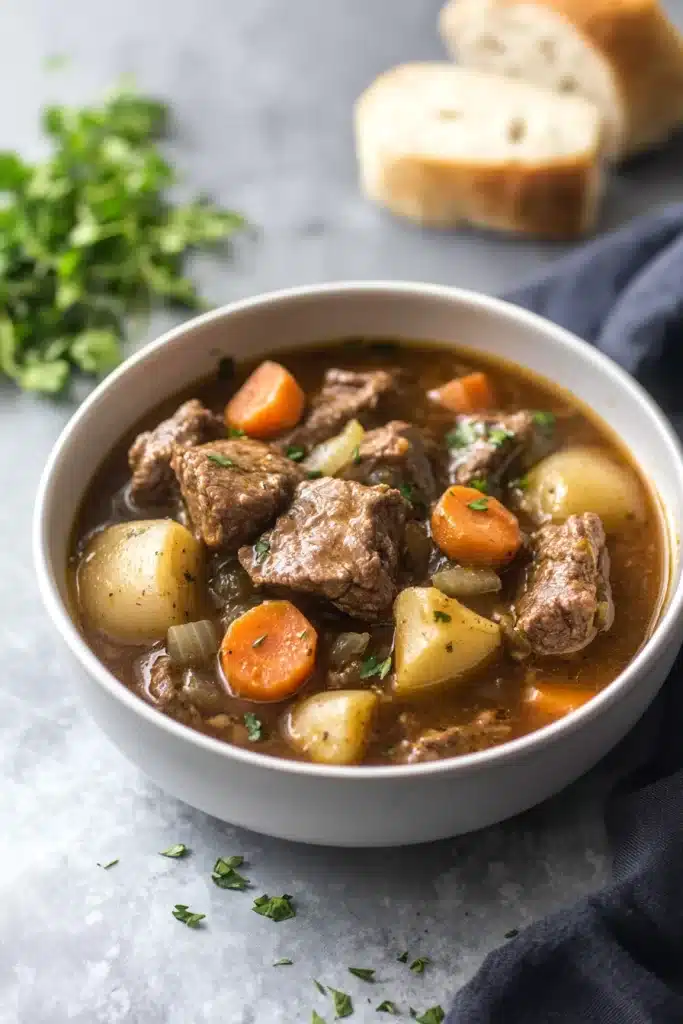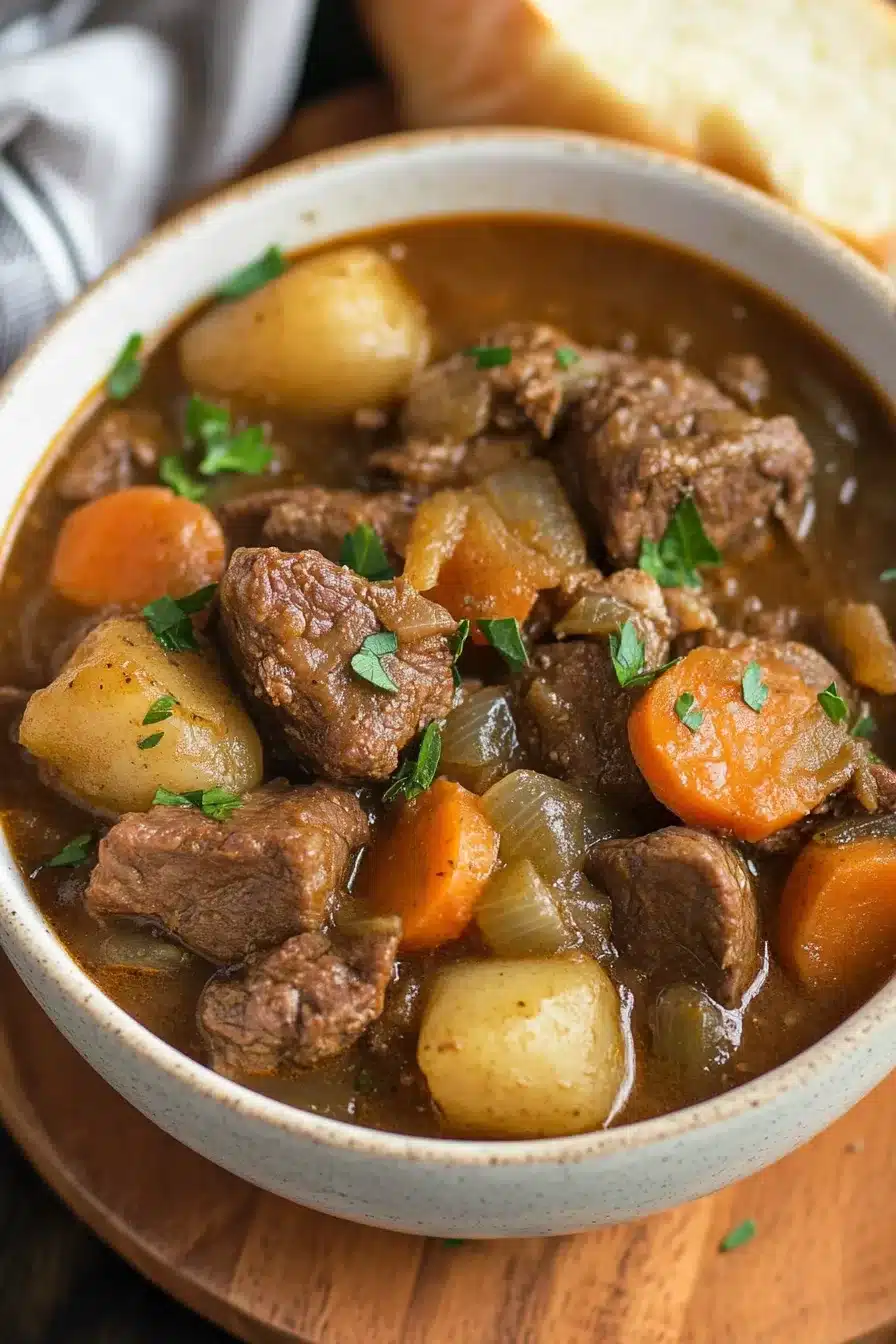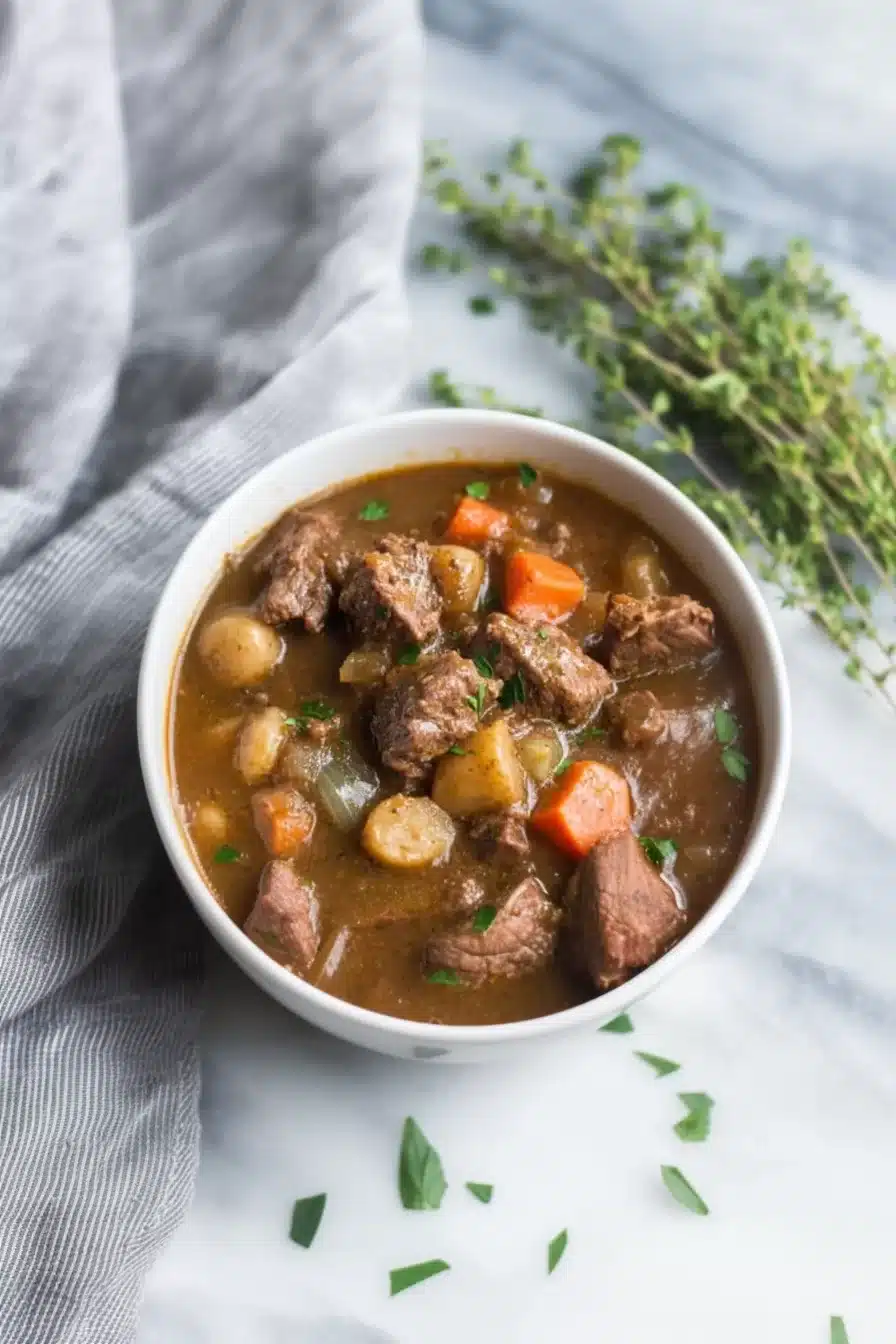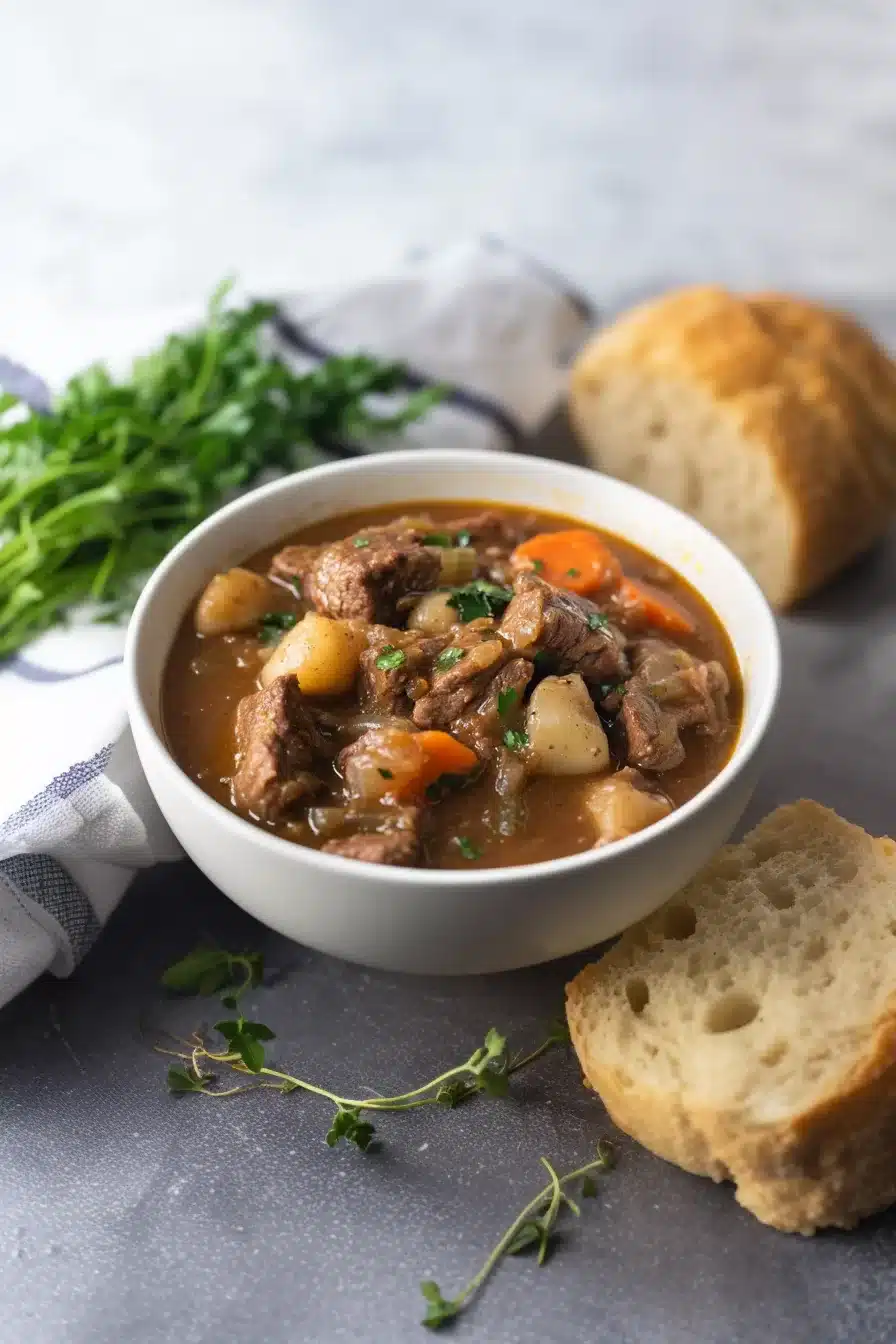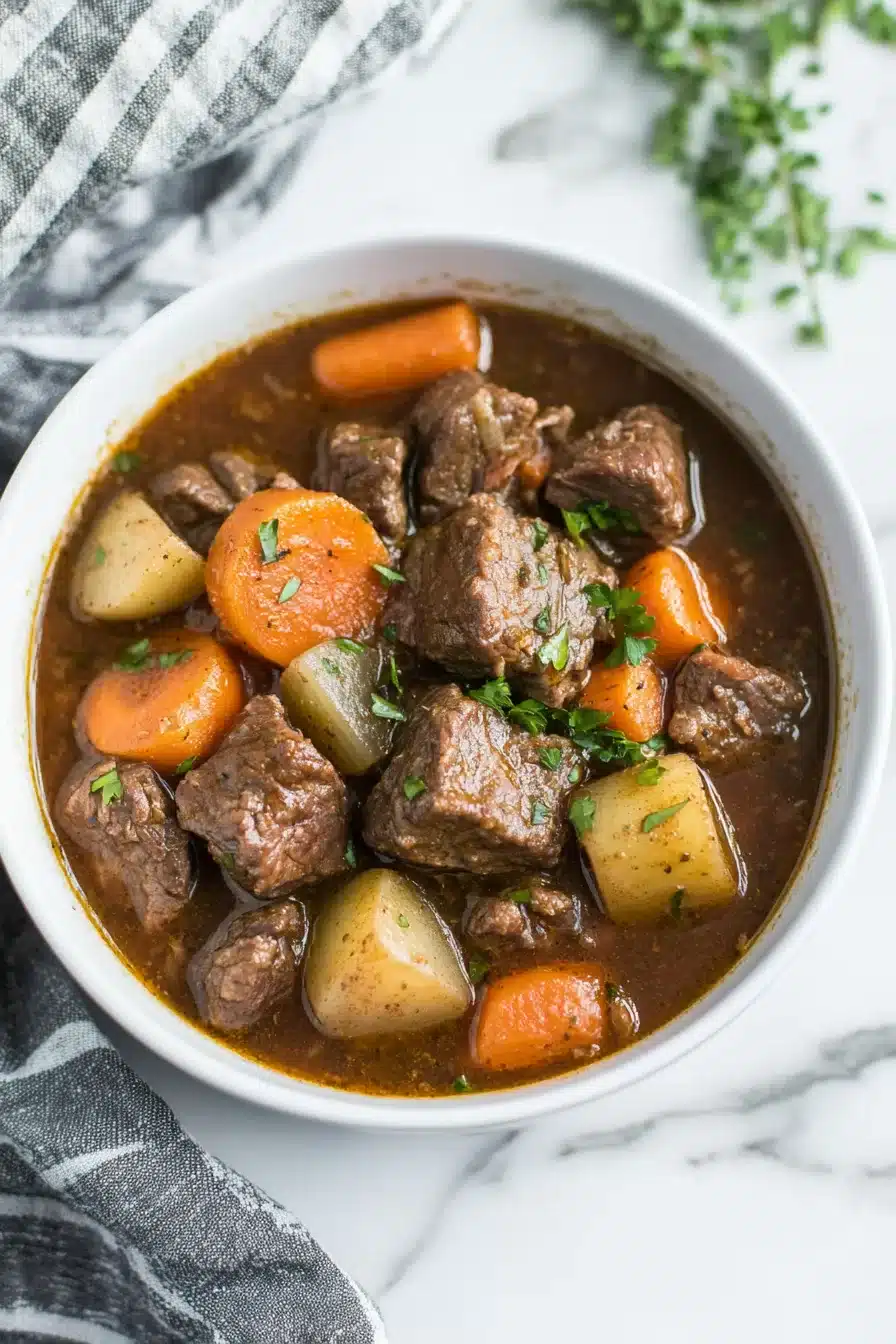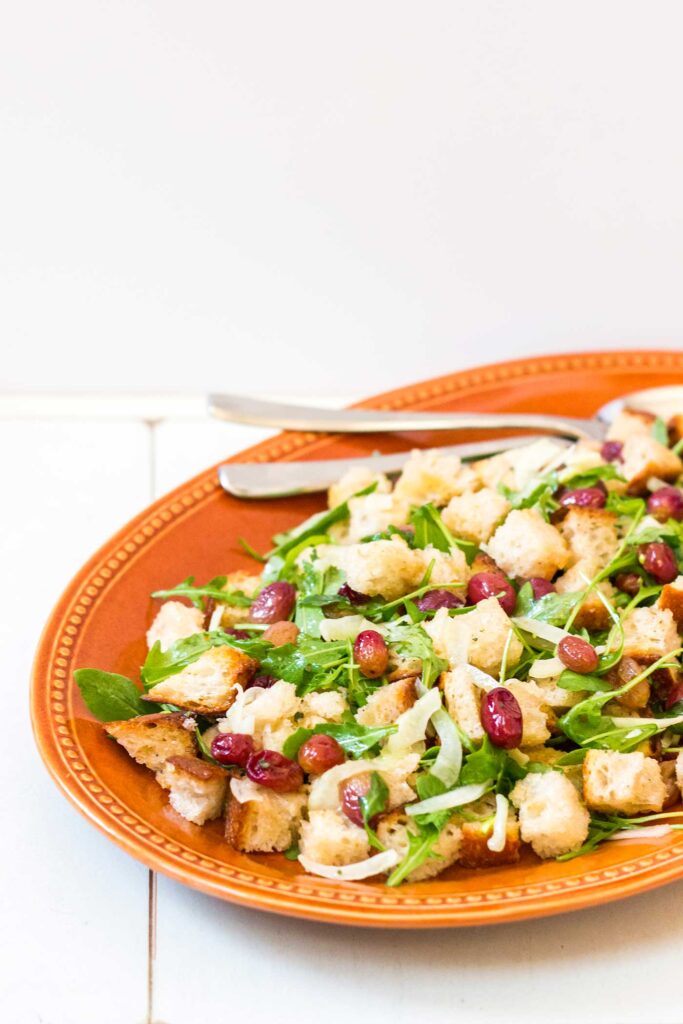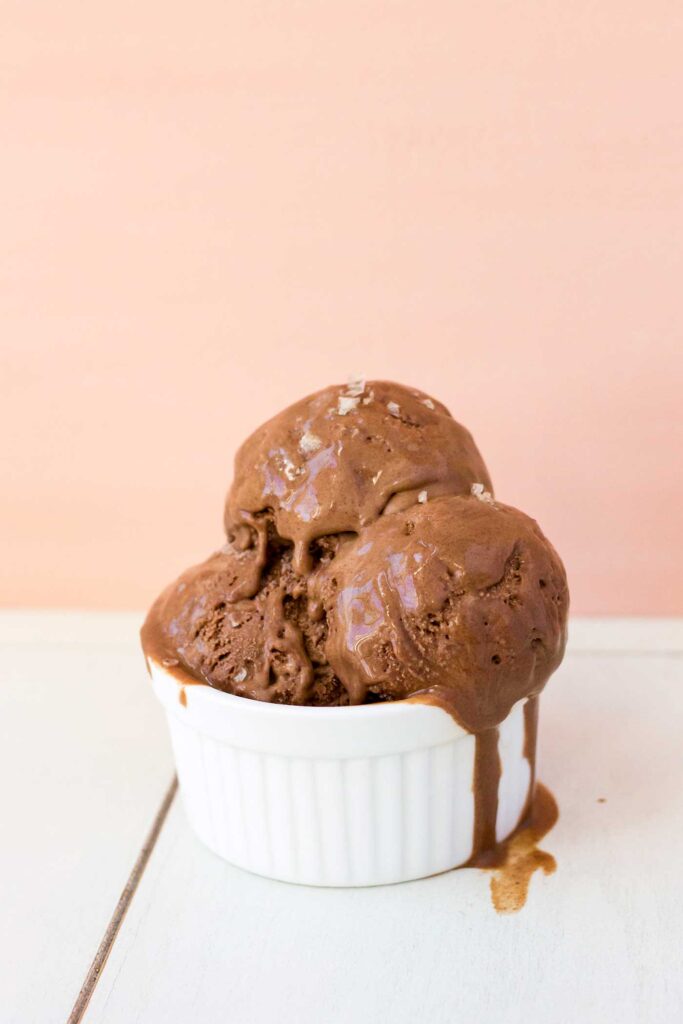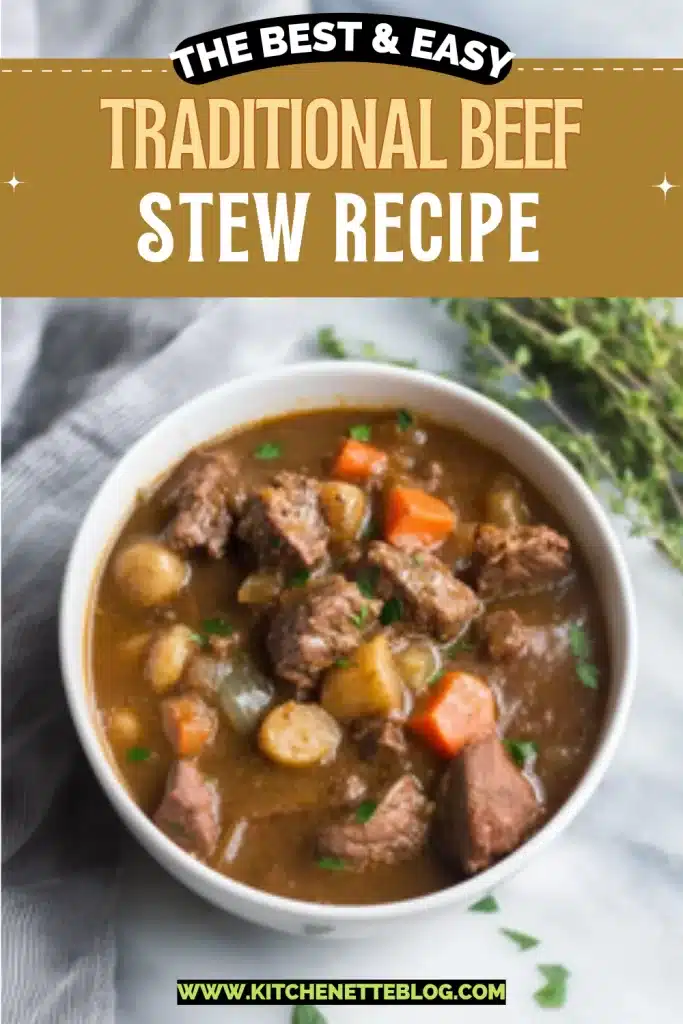
Tender beef, rustic potatoes, and an herby broth that fills the kitchen with the coziest aroma—this old fashioned beef stew comes together with chuck roast, carrots, celery, and a splash of red wine. No frills, just deep comfort in every bite.
If you’ve been craving something hearty and soul-warming, this is it. A steaming bowl of fall-apart beef, silky carrots, and those little bits of onion that practically melt? Yep, that’s what’s simmering here.
There are certain days when all you want is a meal that hugs you back. This is that kind of dish. The kind that simmers away quietly while you half-watch a show and sneak pieces of bread from the cutting board. The broth gets this velvety texture thanks to a quick cornstarch trick (you’ll see), and the smell alone may cause spontaneous swooning.
Also, let’s be honest, anything that lets you toss everything in one big pot and then gives you time to mentally drift while it bubbles? Yes please. This traditional-style stew nails that. It works great as a Sunday dinner, but really, Wednesday nights become 57% better too.
Table of Contents

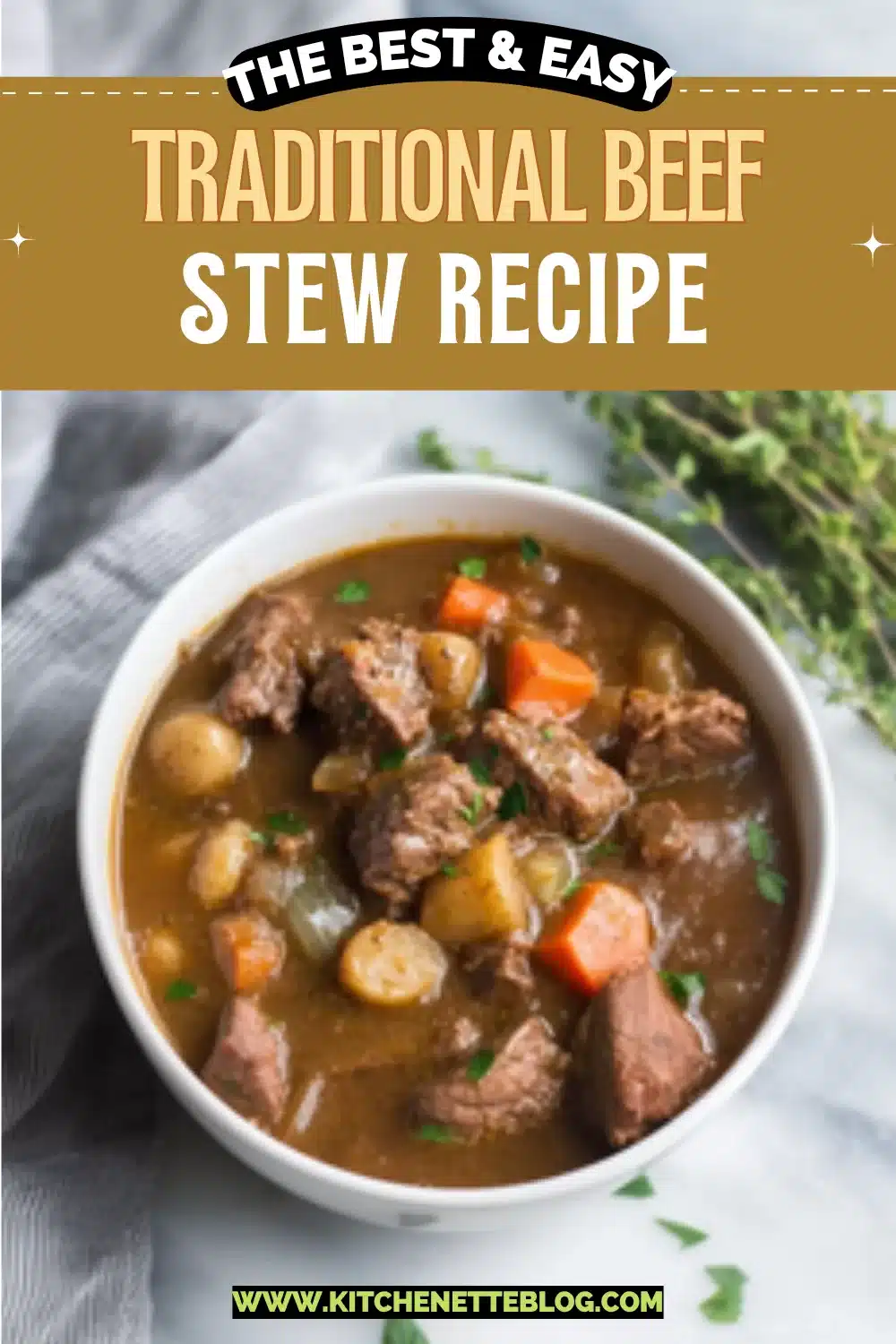

Don’t let this one slip away — pin it now and thank yourself later!
Don’t let this one slip away — pin it now and thank yourself later!
Why You’ll Love this Old Fashioned Beef Stew
No dramatic backstories here, just straight-up comfort food with real staying power. This stew doesn’t try to be flashy—it just tastes like it’s been missing from your life. Or at the very least, from your dinner rotation.
-
Hearty and comforting: Every spoonful is rich, beefy, and perfect for fall, winter… or any day your socks feel like slippers.
-
Deep flavor in one pot: Between the seared beef, red wine, and cozy herbs, it tastes like you cooked all day—even if you didn’t.
-
Leftovers might be better: I don’t make the rules, but something about letting this stew rest overnight turns it magical.
-
No fancy ingredients: It’s meat, potatoes, mirepoix, herbs. You’ve got most of it already hiding in your crisper drawer or pantry.
-
Customizable without drama: You can swap potatoes, ditch the celery, add peas—whatever. This stew forgives.
-
Perfect excuse for carbs: A crusty roll dunked into this broth? Oh yes. Or try it with bacon basil cornbread muffins if you’re feeling bold.
Ingredient Notes
No long shopping lists or obscure ingredients here. Just a few humble pantry staples that rise to greatness when simmered together.
-
Beef chuck roast or stew meat: Chuck roast gives you the best texture—tender and juicy after a slow simmer. Stew meat works in a pinch, though quality can vary.
-
Salt and black pepper: Season generously at the start. It builds a solid flavor base from the first sear.
-
Vegetable oil: For browning the meat. Don’t skip the sear—it’s what gives that deep, rich flavor.
-
Red wine: Adds a little tang and a lot of complexity. Something dry and not too fancy. Cabernet or Merlot work beautifully.
-
Beef broth: Low sodium is best so you can control the saltiness. Homemade earns you bonus points but store-bought totally works.
-
Worcestershire sauce: Just a splash perks everything up. It’s like umami magic.
-
Dried herbs (rosemary, parsley): These give background earthiness. Fresh is great too, just double the quantity.
-
Potatoes: Go for Yukon gold or red potatoes for the perfect soft-but-not-mushy texture.
-
Carrots, celery, onion: The classic trio that adds sweetness, texture, and that good stew base flavor.
-
Cornstarch and cold water: This little slurry thickens the broth just right—glossy, not gloopy.
How To Make This Old Fashioned Beef Stew
Pull out your biggest Dutch oven or heavy-bottomed pot and let’s get this magical pot of coziness going. It’s mostly simmering, promise.
-
Season and sear the beef: Generously salt and pepper the cubed beef, then sear in hot oil until all sides are browned. Don’t crowd the pan—work in batches. You want crusty brown edges, not steam.
-
Deglaze with red wine: After the meat’s done, pour in the wine (cue the sizzle!) and scrape up those browned bits with a wooden spoon. This step adds deep, rich flavor. Smells great already, right?
-
Simmer with broth and spices: Pour in the beef broth, Worcestershire sauce, and sprinkle in rosemary, parsley, and more black pepper. Return the seared beef to the pot, bring everything to a simmer, then cover and cook for an hour on low.
-
Prep your veggies: While it bubbles away, chop your potatoes, carrots, celery, and onion into hearty chunks. Keep them around the same size so they cook evenly.
-
Add veggies and cornstarch slurry: After the first hour of simmering, toss in the vegetables and stir in the cornstarch slurry (just cornstarch mixed with cold water—easy). Give it a good stir to evenly distribute everything.
-
Final simmer: Cover and cook another hour, stirring gently now and then. The meat should be fork-tender, and the veggies should still hold their shape but be soft and comforting.
-
Taste and serve: Give it a taste and adjust salt and pepper if needed. Spoon into bowls while it’s piping hot, ideally with something carb-y nearby.
Storage Options
This stew stores like a champ, honestly. In fact, it might even taste better the next day, once the flavors have cozied up overnight.
Pop any leftovers into an airtight container and stash them in the fridge. It’ll keep for up to 4 days, though let’s be real—mine barely makes it to day two. Reheat gently on the stovetop or in the microwave with a splash of broth or water if it thickens too much.
Want to freeze it? Go for it! Just make sure it’s completely cool first. Freeze in individual portions if you’re clever (easier for weeknight rescue missions) or in one big batch. It’ll last in the freezer for up to 3 months. To reheat, thaw overnight in the fridge, then warm it back up on the stove. Simple.
Variations and Substitutions
If you’re anything like me, you’re already plotting what else you can toss in that pot next time. Good news: this old fashioned beef stew loves a good remix.
-
Sweet potatoes instead of Yukon: They add a cozy sweetness and keep their shape beautifully, especially if you’re aiming for a slightly different vibe.
-
Frozen peas added at the end: Toss them in for the last 5 minutes. Bright green pops and an extra veg boost.
-
Use mushrooms for extra depth: If you’re a fungi fan, sauté some first, then stir them in with the broth. They’ll soak up that savory goodness like sponges.
-
Swap red wine for balsamic vinegar: Just a tablespoon or two will do. You’ll get lovely tang and sweetness without the alcohol.
-
Make it gluten-free: It already kind of is, but double-check your Worcestershire and broth just to be safe.
-
Turn leftovers into a second dish: Toss the stew over egg noodles the next night. Like a stew-meets-pasta hybrid. Totally reminds me of this taco pasta situation.
What to Serve with Old Fashioned Beef Stew
Now that you’ve got this bubbling pot of beefy wonder, let’s talk about what goes alongside it. Because you’re going to want something to catch all that amazing broth.
-
Crusty bread or rolls: Nothing fancy, just something warm and carb-y to mop up the goodness. I like it toasted with a swipe of butter so it half-melts into the stew.
-
Cornbread muffins: A little sweet, a little savory. If you’re up for it, these bacon-basil ones work absurdly well.
-
A crisp green salad: Something acidic and snappy for contrast—think vinaigrette-loaded greens to cut through that rich stew.
-
Buttered egg noodles: Tossed with a little parsley? Yes please. Slide the stew right on top and live your best life.
-
Roasted Brussels sprouts or green beans: If you’re after a cooked veg side, go for something with texture. Crispy edges, a bit of bite, to balance out the stew’s softness.
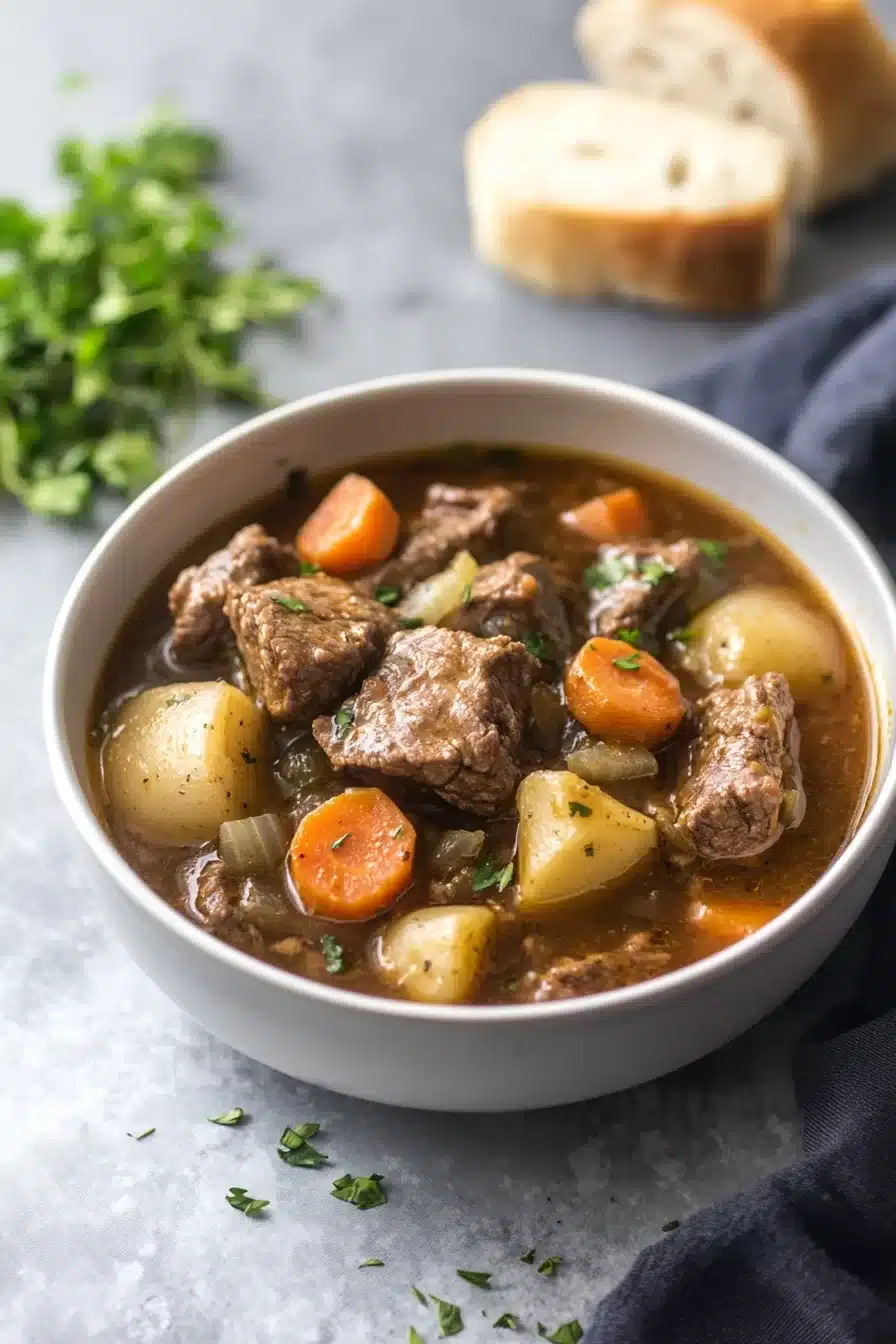

Don’t let this one slip away — pin it now and thank yourself later!
Don’t let this one slip away — pin it now and thank yourself later!
Frequently Asked Questions
Can I make this beef stew in advance?
Oh absolutely, and you should. This stew actually tastes even better after a night in the fridge. The flavors deepen, the meat gets even more tender, and you don’t have to do virtually anything except reheat and eat. Just store it in an airtight container and warm it on the stovetop when you’re ready. Maybe add a splash of broth to loosen it up.
What if I don’t have a Dutch oven?
No worries. Any large pot with a thick bottom will do just fine. The key is to use something that holds heat well and allows for a nice sear on the beef. Avoid thin, cheap pots if you can—they can cause hot spots and uneven cooking. And if you’ve got an oven-safe pot, you could even simmer this in the oven at 325°F instead of on the stove.
Does the wine cook off completely?
Yup, it does. By the time the stew simmers away for two hours, all the alcohol has cooked off—what’s left is just a subtle depth and richness. If you prefer to skip it, a mix of beef broth and a splash of balsamic vinegar or red grape juice can add some similar complexity without the wine.
Can I use another cut of beef?
You can! Chuck roast is the go-to because it softens beautifully over low heat, but other cuts like bottom round or even brisket will work. Just expect a slight difference in texture or cook time. Avoid lean cuts like sirloin though—they’ll dry out quickly and lose that melt-in-your-mouth vibe.
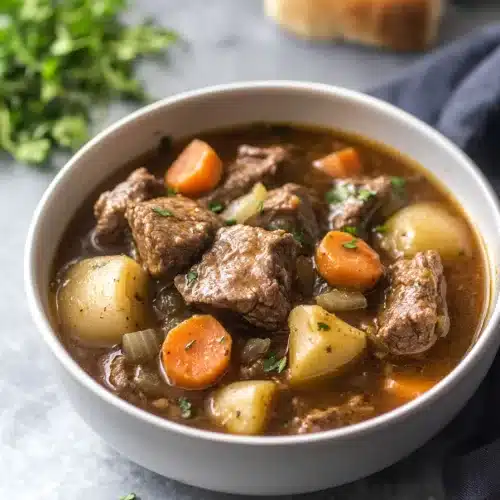
Old Fashioned Beef Stew
Ingredients
Main Stew Ingredients
- 2.5 lbs (1.1 kg) beef chuck roast cut into 1.5-inch cubes
- 1.5 tsp (9 g) salt more to taste
- 1 tsp (2 g) black pepper freshly ground, plus more for serving
- 2 tbsp (30 ml) vegetable oil
- 1 cup (240 ml) dry red wine such as Cabernet or Merlot (optional, see notes)
- 4 cups (950 ml) low sodium beef broth
- 1 tbsp (15 ml) Worcestershire sauce
- 1 tsp (1 g) dried rosemary or 2 tsp fresh, chopped
- 1 tsp (1 g) dried parsley or 2 tsp fresh, chopped
Vegetables
- 1.5 lbs (680 g) Yukon gold potatoes cut into 1-inch chunks
- 4 (240 g) carrots peeled, cut into hearty rounds or chunks
- 3 (110 g) celery stalks chopped
- 1 (150 g) yellow onion chopped
To Thicken
- 2 tbsp (16 g) cornstarch
- 3 tbsp (45 ml) cold water
Equipment
- Dutch Oven
- wooden spoon
- Cutting board
- Chef’s knife
- Measuring cups
- Measuring spoons
- Medium Bowl
Instructions
- Generously season the cubed beef with salt and black pepper. Heat the vegetable oil in a large Dutch oven over medium-high heat. Add the beef in batches, searing until all sides are browned. Set browned beef aside as you work through the batch.
- Once all beef is browned, carefully pour the red wine into the pot. Scrape up the browned bits on the bottom with a wooden spoon. Simmer for 2-3 minutes until slightly reduced.
- Add the beef broth, Worcestershire sauce, dried rosemary, dried parsley, and a few more cracks of black pepper. Stir to combine. Return browned beef and any accumulated juices to the pot.
- Bring to a simmer, then reduce heat to low. Cover and cook for 1 hour.
- While the stew simmers, chop potatoes, carrots, celery, and onion into hearty, even-sized chunks.
- After the first hour, add the potatoes, carrots, celery, and onion to the pot.
- In a small bowl, combine the cornstarch and cold water to create a slurry. Stir this mixture into the stew.
- Cover again and simmer for another hour, stirring gently occasionally, until the beef is fall-apart tender and the vegetables are soft but still hold their shape.
- Taste and adjust seasoning with additional salt and pepper if needed. Serve hot, ideally with crusty bread or a carb of your choice.
Notes
Try sweet potatoes instead of Yukon golds, or add mushrooms with the broth step for extra depth. To make it alcohol-free, use more broth and a tablespoon of balsamic vinegar. Storage:
Stew keeps well in the fridge up to 4 days and may taste even better after a night. Freeze for up to 3 months—thaw overnight in the fridge and reheat gently.

